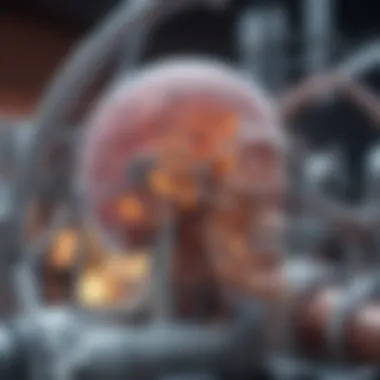Hyperbaric Oxygen Therapy for Lung Cancer


Intro
Hyperbaric oxygen therapy (HBOT) has emerged as an intriguing adjunct in the fight against lung cancer. Understanding this therapy requires dissecting its biological mechanisms and potential benefits, as well as its integration into existing treatment protocols. This article seeks to provide an in-depth analysis by first examining the purpose and relevance of HBOT in oncology, followed by a thorough investigation of its historical roots and fundamental concepts.
Article Overview
Purpose of the Article
The primary aim of this article is to explore the role of hyperbaric oxygen therapy in treating lung cancer. It will elucidate how HBOT works, its clinical efficacy, and the factors influencing patient outcomes. By delving into the nuances of treatment protocols and patient selection criteria, the article provides valuable insights into how HBOT can complement traditional cancer therapies.
Relevance to Multiple Disciplines
HBOT is significant across various fields, including medical oncology, pulmonology, and rehabilitation. Its multifaceted nature bridges gaps between these disciplines, encouraging interdisciplinary collaboration in patient care. Understanding its implications can foster innovative treatment approaches and improve patient outcomes, extending beyond just lung cancer management.
Research Background
Historical Context
The exploration of hyperbaric oxygen therapy has a history dating back to the late 19th century. Initially utilized for decompression sickness, interest in its therapeutic applications expanded over the years. In the context of cancer treatment, HBOT has been investigated for its ability to enhance tumor oxygenation, possibly improving the effectiveness of radiotherapy and chemotherapy.
Key Concepts and Definitions
Several foundational terms must be clarified to grasp the discussion on HBOT:
- Hyperbaric Oxygen Therapy (HBOT): A medical treatment that involves breathing pure oxygen in a pressurized environment. This increases the amount of oxygen dissolved in the blood and delivered to tissues.
- Tumor Hypoxia: Many tumors exist in low-oxygen environments, which can hinder treatment effectiveness. HBOT aims to alleviate this hypoxia and potentially make tumors more susceptible to treatment.
- Adjunct Therapy: A supplemental treatment used alongside primary therapies, such as chemotherapy or radiation, rather than as a standalone option.
"Understanding the mechanisms and applications of hyperbaric oxygen therapy is fundamental to maximizing its therapeutic potential for lung cancer patients."
"Understanding the mechanisms and applications of hyperbaric oxygen therapy is fundamental to maximizing its therapeutic potential for lung cancer patients."
Prolusion
The topic of hyperbaric oxygen therapy (HBOT) for lung cancer is critical, as it intersects with emerging trends in cancer treatment and patient care. Lung cancer remains one of the leading causes of cancer-related deaths globally. The complexity of managing this disease necessitates continuous exploration of alternative and adjunct treatments. Hyperbaric oxygen therapy offers potential advantages that can enhance traditional oncological approaches.
This article will illuminate the relevance of HBOT in lung cancer therapy. HBOT involves the inhalation of pure oxygen in a pressurized environment, which may lead to physiological changes beneficial for cancer treatment. One significant benefit is the increased oxygen supply to tumor tissues, potentially delivering therapeutic effects that could inhibit cancer progression.
Moreover, the therapy could assist in alleviating side effects associated with conventional treatments like chemotherapy and radiation. It may improve patients' overall quality of life and support recovery processes. However, the integration of HBOT into current treatment modalities raises several considerations, including patient selection and treatment protocols.
As an evolving field, understanding the scope of HBOT in this context is essential not just for clinicians, but also for researchers, educators, and students. Each segment of this article will build on aspects such as the mechanisms of HBOT, clinical evidence supporting its efficacy, and the challenges facing its application in oncology. By addressing these elements comprehensively, this article aims to provide a thoughtful examination of HBOT as a promising adjunct treatment in lung cancer management.
"The integration of innovative therapies like HBOT could redefine patient care in oncology, particularly for lung cancer."
"The integration of innovative therapies like HBOT could redefine patient care in oncology, particularly for lung cancer."
Through a meticulous analysis, we will explore how hyperbaric oxygen therapy may play a pivotal role in the future of lung cancer treatment.
Understanding Hyperbaric Oxygen Therapy
Hyperbaric Oxygen Therapy (HBOT) is an advanced medical treatment involving the inhalation of 100% oxygen in a pressurized environment. This therapy is gaining attention in the treatment of various health conditions, including lung cancer. The significance of understanding HBOT lies in its potential to enhance treatment outcomes, alleviate symptoms, and improve overall quality of life for patients dealing with this serious illness. It is crucial to examine its underlying mechanisms, historical context, and modern applications in clinical care to grasp its value fully.
Definition and Mechanism
Hyperbaric Oxygen Therapy is defined as a treatment method where patients breathe pure oxygen while inside a pressurized chamber. The increased atmospheric pressure allows oxygen to dissolve more readily into the bloodstream, delivering it to tissues that may not receive sufficient oxygen otherwise. Understanding this mechanism is important because cancerous tissues often have compromised blood supply and oxygenation, which can hamper effective treatment.
The main mechanisms through which HBOT exerts its effects in lung cancer therapy include:
- Enhanced oxygen delivery: Oxygen can damage cancer cells and improve the efficacy of certain treatments like radiation therapy.
- Anti-inflammatory effects: HBOT can reduce inflammation around tumors, potentially easing symptoms and enhancing the patient’s ability to tolerate treatments.
- Promotion of healing: For patients undergoing surgery or who have undergone radiation, HBOT may facilitate quicker recovery times by improving overall tissue oxygenation, essential for healing.
Historical Context of HBOT
The roots of hyperbaric therapy trace back to the 17th century when Dr. Henshaw first used a pressurized chamber for medical purposes. However, it was not until the 20th century that clinical applications expanded. Historically, HBOT was primarily associated with the treatment of decompression sickness and carbon monoxide poisoning. Over time, research began to reveal its utility in a broader array of conditions, including chronic wound healing and more recently, cancer treatment.


The evolving understanding of oxygen's role in cancer therapy has led to renewed interest in HBOT. As research accumulates, its application against various cancer types, particularly lung cancer, gains traction. This historical perspective emphasizes how medical knowledge evolves, paving the way for innovative treatment strategies grounded in long-existing principles.
Current Applications in Medicine
In contemporary medicine, HBOT has been applied to treat several conditions, including:
- Decompression sickness: Originally the primary use of HBOT, still relevant for divers and related cases.
- Radiation-induced tissue damage: This is particularly significant for cancer patients who undergo radiation therapy, as it can alleviate tissue injuries.
- Non-healing wounds: Chronic wounds, typical in diabetes patients, significantly benefit from HBOT, as improved oxygenation assists in healing processes.
In cancer treatment, specifically, HBOT is being explored as an adjunct therapy. The idea here is that it enhances the effectiveness of conventional treatments such as chemotherapy and radiation, particularly by targeting oxygen-deficient tumor regions. Currently, various clinical trials are assessing these applications specifically for lung cancer, focusing on the integration of HBOT into established treatment protocols.
"As we explore the potential of HBOT in oncology, we must recognize the need for thorough research and patient-specific considerations to maximize the benefits while minimizing risks."
"As we explore the potential of HBOT in oncology, we must recognize the need for thorough research and patient-specific considerations to maximize the benefits while minimizing risks."
By comprehending hyperbaric oxygen therapy's definition, historical context, and current applications, healthcare professionals, patients, and researchers can better appreciate its role. Understanding these elements is paramount as a foundation for utilizing HBOT in lung cancer, ensuring that it becomes an informed part of a comprehensive cancer treatment strategy.
Lung Cancer Overview
Lung cancer represents a significant public health challenge, contributing to high mortality rates globally. This section is crucial as it fosters an understanding of the fundamental aspects of lung cancer, paving the way for the exploration of hyperbaric oxygen therapy (HBOT) as a potential adjunct treatment. Recognizing the epidemiology, pathophysiology, and current treatment modalities sheds light on the necessity for innovative therapeutic approaches. Understanding these elements is vital for researchers, students, and healthcare professionals alike.
Epidemiology and Statistics
Lung cancer ranks as one of the most prevalent cancers and a leading cause of cancer-related deaths worldwide. According to the World Health Organization, lung cancer accounts for approximately 1.8 million deaths annually. Notably, there are two primary types of lung cancer: non-small cell lung cancer (NSCLC) and small cell lung cancer (SCLC). NSCLC is more common, representing about 85% of cases.
Some key statistics underline the severity of this disease:
- The American Cancer Society estimates that over 235,000 new cases of lung cancer will be diagnosed in the United States alone in 2021.
- Mortality rates for lung cancer are stark, with a five-year survival rate of only about 19%, largely due to late-stage diagnosis.
- Risk factors include smoking, exposure to secondhand smoke, and environmental pollutants, which amplify the imperative need for effective treatment options.
These statistics raise awareness about the urgency in addressing lung cancer treatment and palliative care.
Pathophysiology of Lung Cancer
The pathophysiology of lung cancer involves complex biological processes. Lung cells undergo mutations due to various carcinogenic agents, leading to uncontrolled cell growth. These changes can lead to tumor development, affecting lung function and causing symptoms such as cough, chest pain, and weight loss.
Understanding the pathophysiological mechanisms provides insights into how therapies, including HBOT, might influence tumor biology. Key features of the pathophysiology include:
- Oncogene activation: Mutations in genes such as EGFR and KRAS can lead to aberrant signaling pathways that promote tumor growth.
- Tumor microenvironment: The surrounding environment affects tumor progression. Factors like hypoxia, acidosis, and inflammation can exacerbate cancer growth.
- Metastasis: Lung cancer's ability to spread to other organs complicates treatment options and affects survival rates.
This knowledge highlights the importance of novel strategies that could potentially target these processes.
Current Treatment Modalities
Current treatment modalities for lung cancer include surgery, radiation therapy, chemotherapy, and targeted therapies. The choice of treatment largely depends on the cancer stage and individual patient factors.
- Surgery is often the first-line treatment for early-stage localized lung cancers. It involves the removal of the tumor and surrounding lung tissue.
- Radiation therapy can be useful in both curative and palliative settings, especially for patients unable to undergo surgery.
- Chemotherapy employs cytotoxic drugs to kill cancer cells, often administered in combination regimens. This is particularly common for SCLC.
- Targeted therapies have emerged as viable options for NSCLC, especially drugs that target specific mutations such as ALK and EGFR inhibitors.
Despite progress, treatment gaps and adverse effects often necessitate supplemental therapies, making HBOT an area of interest for improving patient outcomes.
Understanding lung cancer through these lenses allows for deep reflection on the potential roles of emerging therapies like HBOT.
Mechanisms of HBOT in Cancer Therapy
The study of mechanisms underlying hyperbaric oxygen therapy (HBOT) in cancer therapy is crucial in understanding how this treatment may enhance conventional cancer therapies. This section will explore the biological processes that HBOT influences in cancer treatment, emphasizing its impact on oxygenation, angiogenesis, and immune response. Each of these mechanisms plays a significant role in shaping the tumor environment and potentially improving patient outcomes.
Oxygenation and Tumor Biology
Oxygen is fundamental to the metabolic processes of all cells, including cancerous ones. Tumors often exist in low-oxygen environments, known as hypoxia, which can contribute to their aggressive nature. Hypoxia not only facilitates uncontrolled tumor growth but also renders conventional therapies less effective. Increased oxygen levels via HBOT can help mitigate this issue. By enhancing oxygenation, HBOT promotes apoptosis in tumor cells and damages their DNA, which compromises their ability to proliferate.
Research indicates that reoxygensation of tumor tissues can lead to improved sensitivity to radiation therapy. When tumors are adequately oxygenated, they absorb radiation more effectively. This interaction is crucial, as it can enhance the overall effectiveness of radiation treatment and potentially reduce the amount of radiation needed, lowering side effects for patients.
Effects on Angiogenesis


Angiogenesis, the formation of new blood vessels, is critical for tumor growth and sustenance. Tumors secrete various growth factors that stimulate this process. HBOT influences angiogenesis by affecting the balance of pro-angiogenic and anti-angiogenic factors in the tumor microenvironment. Evidence shows that increased oxygenation can inhibit certain pathways, reducing unnecessary blood vessel growth that tumors exploit. Conversely, under some conditions, HBOT may also stimulate the formation of normal blood vessels, which supports healthy tissue repair.
An example of this is the vascular endothelial growth factor (VEGF), a key player in angiogenesis. HBOT can alter VEGF expression, impacting tumor-related blood supply. By fine-tuning these angiogenic responses, HBOT holds promise in combating the deleterious effects of insufficient vascular supply in tumors.
Role in Immune Modulation
The immune system plays a pivotal role in controlling and eradicating cancer. However, tumors often develop strategies to evade immune detection. HBOT can modulate this immune response positively. Enhanced oxygen levels may improve the functionality of immune cells, including T-cells and natural killer cells, thereby augmenting their ability to detect and attack cancer cells.
Moreover, HBOT can reduce inflammation in surrounding tissues, creating a more favorable environment for immune action against tumors. Studies have shown that patients undergoing HBOT exhibit improved immune profiles, which may correlate with better treatment outcomes.
Given the significance of these mechanisms, ongoing research into HBOT could warrant new strategies for integrating this therapy into existing oncology practices. As the body of clinical evidence supporting these mechanisms grows, the potential benefits of HBOT for lung cancer treatment may become more apparent, highlighting a novel approach for enhancing therapeutic efficacy.
Clinical Evidence for HBOT in Lung Cancer
The exploration of hyperbaric oxygen therapy (HBOT) in lung cancer treatment stands as a significant facet of cancer research. It integrates understanding from both clinical practice and theoretical studies. The potential benefits of HBOT in this specific domain merit thorough investigation. This section reviews critical clinical evidence that underscores the rationale for employing HBOT as part of comprehensive care for lung cancer patients.
Preclinical Studies
Preclinical studies serve as the foundational block in assessing the efficacy of HBOT for lung cancer. These studies primarily utilize animal models to explore biological responses to increased oxygen levels under pressure. In these settings, researchers observe altered tumor growth rates and changes in the tumor microenvironment. Published research indicates that HBOT can enhance the uptake of oxygen in hypoxic, or poorly oxygenated, tumor areas. This environment is typically resistant to conventional therapies. By increasing oxygen saturation, HBOT may make tumors more susceptible to treatments such as radiation and chemotherapy.
For instance, certain studies documented that combining HBOT with radiation therapy significantly slowed the growth of specific lung cancer types in animal models. This illustrates a potential synergistic effect that could translate into improved outcomes for human patients. Overall, preclinical findings are promising and advocate for further exploration in clinical settings.
Clinical Trials and Their Outcomes
Clinical trials are essential for translating preclinical outcomes into applicable human treatments. Several trials have been conducted to evaluate the effectiveness and safety of HBOT in patients with lung cancer. These clinical studies often differ in design, target populations, and methodology but share the common goal of understanding HBOT's role in clinical oncology.
The outcomes of these trials reveal mixed findings, but some trials show noteworthy benefits. Patients receiving HBOT reported a reduction in treatment-related side effects, such as radiation-induced lung injury. Furthermore, certain studies highlighted improvements in overall quality of life and lung function metrics among participants. A significant takeaway from many of these trials is the need for tailored protocols. Different lung cancer types may respond variably to HBOT, necessitating personalized treatment plans based on patient-specific factors.
"Clinical evidence supports the notion that HBOT could play a role in enhancing conventional therapies and improving patient quality of life."
"Clinical evidence supports the notion that HBOT could play a role in enhancing conventional therapies and improving patient quality of life."
Efficacy in Combination with Other Treatments
Combining HBOT with other treatments has gained interest among researchers. The rationale behind this approach lies in the desire to maximize therapeutic efficacy while minimizing adverse effects. Evidence suggests that when used alongside chemotherapy and radiation, HBOT may enhance the effectiveness of these treatments. The precise mechanisms are still under investigation; however, the increase in oxygen levels is believed to counteract the hypoxic conditions found in tumors, thus improving the response to systemics.
In addition, some clinicians have reported that using HBOT during post-surgical recovery can facilitate healing and minimize complications. This alignment of HBOT with traditional modalities marks a progressive step towards integrative cancer care. While careful consideration must be given to patient selection and treatment timing, the preliminary data indicates potential advantages in this multidimensional therapy approach.
In summary, the evidence surrounding HBOT in lung cancer continues to evolve, highlighting its potential as a complementary therapy within oncology. Further research is necessary to substantiate benefits and refine treatment protocols.
Potential Benefits of HBOT for Lung Cancer Patients
The application of hyperbaric oxygen therapy (HBOT) in treating lung cancer presents multiple potential benefits for patients. Understanding these advantages is crucial, as it can influence treatment decisions and improve overall patient outcomes. This section explores these benefits in detail, focusing particularly on how they can positively affect patients undergoing conventional cancer therapies.
Reduction of Treatment-Related Side Effects
One of the most significant benefits of HBOT for lung cancer patients is its potential to reduce treatment-related side effects. Patients undergoing treatments like chemotherapy or radiation therapy often experience adverse effects that can diminish their quality of life. These side effects may include debilitating fatigue, nausea, skin irritation, and compromised immune function. By increasing the oxygen available to tissues, HBOT may help mitigate some of these symptoms.
Research suggests that higher oxygen levels can enhance healing and repair in damaged tissues, potentially leading to quicker recovery from side effects. For instance, patients receiving radiation often experience skin damage, which may be alleviated when subjected to HBOT. This therapy allows for better blood circulation and may promote skin regeneration, thus reducing discomfort during treatments.
Improved Quality of Life Metrics
Quality of life is a paramount concern for lung cancer patients. The physical and emotional toll of the disease and its treatment can be overwhelming. Hyperbaric oxygen therapy has been shown to have a positive impact on overall quality of life metrics. Patients who undergo HBOT often report improvements in fatigue levels, anxiety, and overall well-being.
Notably, clinical assessments indicate that individuals receiving HBOT experience fewer symptoms of depression and anxiety. Alleviating such psychological stressors is essential in the holistic management of cancer, as mental health significantly influences physical health outcomes. Additionally, the increased energy levels often reported by patients post-HBOT contribute to a greater sense of autonomy and engagement in daily life activities.
Enhancement of Survival Rates
Another critical advantage of HBOT is its potential role in enhancing survival rates among lung cancer patients. While studies on this aspect are still evolving, preliminary research indicates that HBOT may improve treatment efficacy by augmenting the body's response to cancer therapies. Enhanced oxygenation can optimize the effectiveness of chemotherapy and radiation treatments, potentially leading to better long-term outcomes.
"The integration of HBOT in cancer treatment plans offers a multi-faceted approach that addresses both physical and psychological challenges faced by patients."


"The integration of HBOT in cancer treatment plans offers a multi-faceted approach that addresses both physical and psychological challenges faced by patients."
Moreover, the role of oxygen in tumor hypoxia is vital. Many tumors exhibit low oxygen levels, which can contribute to treatment resistance. By improving oxygen delivery to hypoxic tumor sites, HBOT may help sensitize tumors to treatment, thus increasing the likelihood of a favorable prognosis.
In summary, the benefits of hyperbaric oxygen therapy for lung cancer patients are multifaceted, spanning from reducing side effects and enhancing quality of life metrics to potentially improving survival rates. By considering the role of HBOT in the overall treatment strategy for lung cancer, healthcare providers can provide more comprehensive care that addresses various dimensions of patient health.
Challenges and Limitations of HBOT in Oncology
The application of Hyperbaric Oxygen Therapy (HBOT) within oncology presents various challenges and limitations. Understanding these impediments is crucial for assessing the overall efficacy of HBOT as a treatment adjunct for lung cancer. This section will delve into the financial barriers, patient selection issues, and regulatory challenges faced by practitioners and patients alike. These factors are essential in determining how effectively HBOT can be integrated into established cancer treatments.
Cost and Accessibility Issues
One of the most pronounced challenges with HBOT is the cost associated with the treatment. Hyperbaric chambers require substantial investment in infrastructure, maintenance, and training of personnel. This high economic burden can limit access to HBOT facilities, particularly in underfunded healthcare systems. Moreover, insurance coverage for HBOT varies significantly. Many insurance companies consider it experimental for oncology applications, refusing to cover costs, which can deter patients from seeking this therapy.
Accessibility to HBOT facilities is another pressing issue. Not all cancer treatment centers offer HBOT, and patients may need to travel significant distances to access these services. Such logistical hurdles can lead to delays in treatment and can contribute to poor patient compliance. For certain populations, particularly those with limited mobility or financial resources, the accessibility issue presents a formidable barrier to the uptake of HBOT.
Patient Selection Considerations
The effectiveness of HBOT in lung cancer treatment is not uniform across all patients. Certain factors influence whether an individual is a suitable candidate for this therapy. Medical history, stage of cancer, and overall health are significant determinants. For instance, patients with pre-existing lung conditions may not tolerate increased oxygen levels well, leading to potential complications.
Additionally, patient selection is complicated by the heterogeneity of lung cancer itself. Different types of lung cancer may respond variably to HBOT. Oncologists must carefully evaluate the potential benefits versus risks for each patient, considering their specific cancer characteristics and treatment goals. This nuanced decision-making requires a comprehensive understanding of the latest research and clinical guidelines.
Regulatory and Standardization Challenges
The regulatory landscape surrounding HBOT in oncology is complex and often inconsistent. Variations in state and federal regulations can affect the availability and acceptance of HBOT as a legitimate treatment option. This inconsistency can create uncertainty for both healthcare providers and patients.
Moreover, standardization of treatment protocols is essential to ensure the effectiveness and safety of HBOT. Current practices may vary widely based on geographical location, facility capabilities, and physician preference. Without harmonized treatment guidelines, it becomes challenging to assess the full potential of HBOT in clinical settings. Setting standards can improve patient outcomes and facilitate larger scale studies to validate its efficacy as an adjunct cancer therapy.
"Overcoming these challenges requires a collaborative approach, integrating healthcare providers, regulatory bodies, and researchers to pave the way for more effective HBOT applications in oncology."
"Overcoming these challenges requires a collaborative approach, integrating healthcare providers, regulatory bodies, and researchers to pave the way for more effective HBOT applications in oncology."
Future Directions in HBOT Research
The investigation into hyperbaric oxygen therapy (HBOT) is evolving rapidly. It has the potential to revolutionize the way lung cancer is treated. Understanding future directions in HBOT research is crucial for several reasons. First, it opens new avenues for enhancing treatment protocols. Second, it emphasizes innovative technologies that improve patient outcomes. Lastly, the ongoing research will inform the standardization efforts necessary to integrate HBOT into conventional cancer care.
Emerging Technologies in HBOT
Recent advancements in HBOT technologies are making therapy more effective and accessible. One promising area is the development of portable hyperbaric chambers. These devices could allow for outpatient treatment options, greatly increasing the outpatient accessibility of HBOT. In addition, improvements in monitoring systems for patients undergoing therapy can ensure safety and efficacy.
Moreover, biomarkers are being explored to predict patient responses to HBOT. Tailoring treatments based on individual biology could lead to more successful outcomes. Another significant development is the use of combined therapies, where HBOT is administered alongside immunotherapy or chemotherapy. This can potentially enhance the overall effectiveness of cancer treatments, providing a synergistic effect that could lead to improved survival rates.
Innovative Treatment Protocols
As research expands, innovative treatment protocols are being investigated. Current protocols focus primarily on standardized treatment durations and pressures. However, ongoing studies are evaluating varied pressures and durations, aiming to customize treatment to the individual patient's needs. This personalization may optimize the response of lung cancer cells to oxygen therapy.
Certain studies have even suggested modifying treatment schedules to align with the timing of other cancer therapies.* For instance, administering HBOT immediately after chemotherapy might maximize tumor oxygenation and help mitigate side effects. *This integrated approach could transform how clinicians approach lung cancer treatment.
Longitudinal Studies and their Importance
Longitudinal studies are essential in understanding the long-term impacts of HBOT on lung cancer patients. These studies track patients over extended periods, providing data on survival rates, quality of life, and potential late effects of HBOT.
Such research can validate the efficacy of HBOT as an adjunct therapy in lung cancer care. Without long-term data, it is challenging to establish definitive guidelines or protocols. Moreover, these studies help delineate which patient populations benefit most from HBOT, making it easier to identify suitable candidates.
In summary, exploring the future of HBOT research is vital for healthcare practitioners and patients alike. Advancements in technology, innovative treatment protocols, and the significance of longitudinal research will guide the integration of HBOT into clinical practice, potentially enhancing the treatment landscape for lung cancer patients.
Epilogue
In this article, we have explored the multifaceted role of hyperbaric oxygen therapy (HBOT) in the context of lung cancer treatment. The conclusion draws together the key insights and highlights the significance of ongoing research and clinical applications.
First, the potential of HBOT as an adjunct therapy is notable. Its mechanisms, such as enhancing oxygenation and modulating immune responses, may serve to improve the efficacy of traditional cancer treatments. There is growing evidence that integrating HBOT can lead to better patient outcomes, particularly concerning symptom relief and quality of life. This integration is crucial as lung cancer therapy often presents complex challenges, requiring innovative approaches to enhance patient care.
Secondly, considerations regarding patient selection are paramount. Not all patients may benefit equally from HBOT. Factors such as overall health, cancer stage, and co-existing medical conditions define eligibility. Thus, a thorough assessment is necessary to identify those who are most likely to experience benefits.
Furthermore, the regulatory landscape remains a challenge. Standardization of treatment protocols is imperative to ensure consistency and safety across the board. As more clinical trials emerge, converging data can provide clearer guidelines and best practices for healthcare professionals.
"The journey towards adopting HBOT in oncology requires thoughtful deliberation and rigorous research to unlock its full potential."
"The journey towards adopting HBOT in oncology requires thoughtful deliberation and rigorous research to unlock its full potential."



